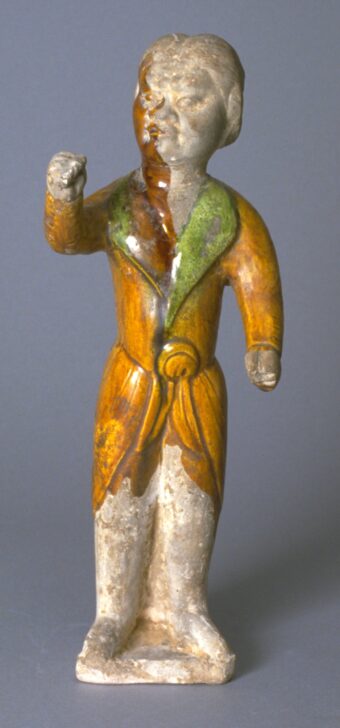Central Asian Groom
Chinese

Description
Subject Matter:
This is an earthenware sancai (三彩, literally "three color") mingqi (明器, literally "bright objects") figure of the Tang dynasty (618-906). The presence of a Central Asian groom within the tomb would indicate the wealth and high status of the occupant, being not only well-to-do but also cultured and cosmopolitan. The clothing style and facial features are indicative of the ethnicity of the groom, who has one hand raised as if pulling on the reigns of a horse. Historical Chinese records confirm that Central Asians were often entrusted by the court to train horses.
During the stable and peaceful Tang Dynasty, the Silk Road brought exotic luxury goods to China, including metalwork, glass, precious stones, ivory, and textiles from Central Asian, India, and the Middle East. The bustling Tang capital of Chang’an (modern Xi’an) was a bit like the Paris and New York of today in its cosmopolitan mix of peoples, cultures, music, foods, and goods, especially from Central Asia.
Sancai was one of the most brilliant innovations of Tang dynasty potters. Working with the same clay used to produce white wares, potters added iron, copper, and cobalt oxide colorants to create the typical three-color palette of cream, amber, olive green and cobalt blue. Sancai ware can contain any combination of just two to all four colors. Cobalt oxide was a new import from Persia and was a key component in the development of the three-colored glaze palette. Lead flux made it possible for these colored glazes to fuse to the earthenware body at relatively low kiln temperatures. It also allowed glazes to run, which made them very difficult to control, yet aesthetically appealing.
Sancai, flourished from around 680 to 750 under the patronage of the Tang elite for the production of tomb figurines and mingqi, or funerary pottery. Since the Qin dynasty (221 - 206 BCE), ceramic figures have been used to replace human sacrifice in burial practices as a way to provide for the deceased. The number of ceramic mingqi items in a tomb could reach numbers of a few to several hundred objects.
Physical Description:
An earthenware figure of a man wears pants and a long coat with tight sleeves and a wide collar belted at the waist. He stands on a square platform with one hand raised. His face has a wide nose, big eyes, and big lips; his hair is pleated down the middle and braided around his head. The coat is colored in amber and green glazes.
Usage Rights:
If you are interested in using an image for a publication, please visit https://umma.umich.edu/request-image/ for more information and to fill out the online Image Rights and Reproductions Request Form.